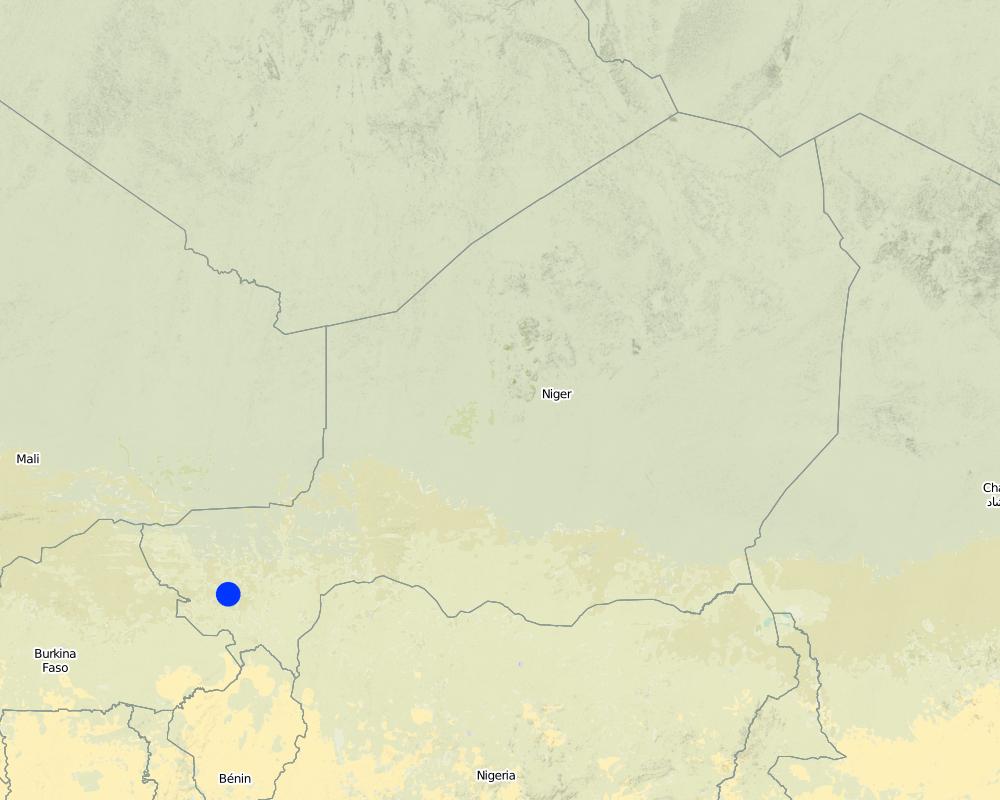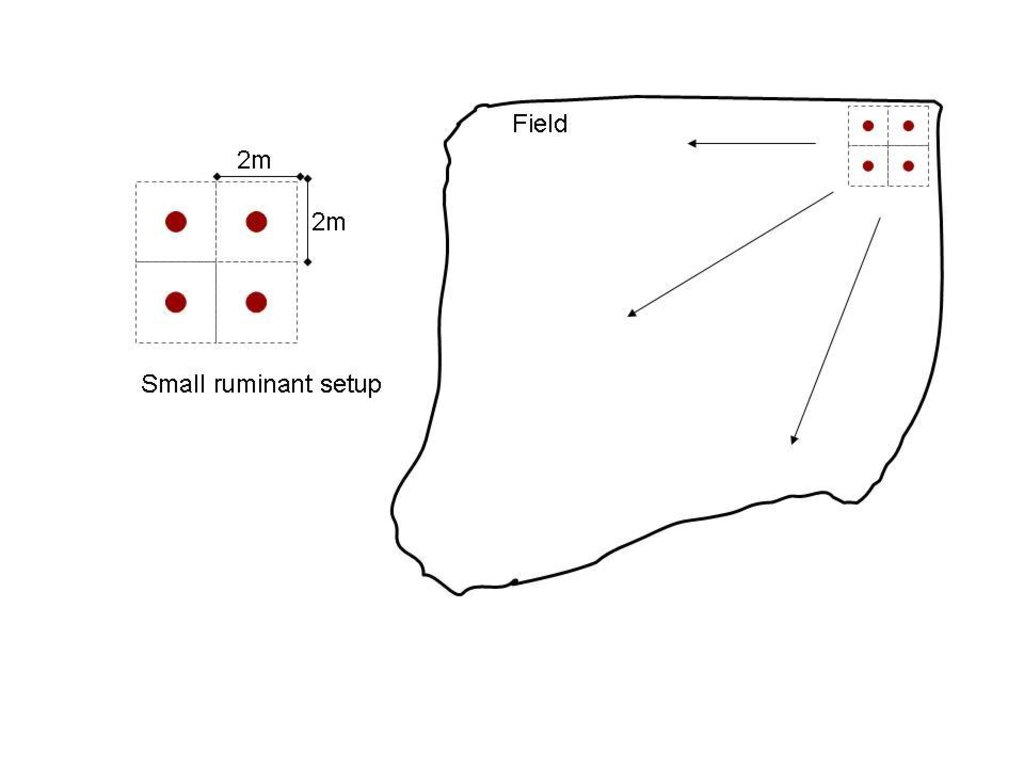Night Corralling [尼日尔 ]
- 创建:
- 更新:
- 编制者: Unknown User
- 编辑者: –
- 审查者: David Streiff, Alexandra Gavilano, Deborah Niggli
technologies_952 - 尼日尔
查看章节
全部展开 全部收起1. 一般信息
1.2 参与该技术评估和文件编制的资源人员和机构的联系方式
关键资源人
SLM专业人员:
Schlecht Eva
Georg-August Universität
德国
有助于对技术进行记录/评估的项目名称(如相关)
Book project: SLM in Practice - Guidelines and Best Practices for Sub-Saharan Africa (SLM in Practice)有助于对技术进行记录/评估的机构名称(如相关)
Georg August Universität Göttingen (Georg August Universität Göttingen) - 德国1.3 关于使用通过WOCAT记录的数据的条件
编制者和关键资源人员接受有关使用通过WOCAT记录数据的条件。:
是
2. SLM技术的说明
2.1 技术简介
技术定义:
Night corralling of cattle, sheep and goats on cropland during the dry season (November-April) replenishes soil fertility of agricultural land depleted by continuous cropping.
2.2 技术的详细说明
说明:
This technology is mainly applied in semi-arid and sub-humid areas on sandy/loamy plains with low soil organic matter content, low soil pH, and with slopes below 5%. Adequate spacing of animals helps to homogenously distribute the manure on the field (see photo): in cattle this is ensured through tying the animals to poles, in sheep and goats a movable fence serving as night enclosure helps to save labour. Corals and animals are moved to a new spot within the field every 4-5 nights to homogeneously manure fields. Ideal is a rate of 2.5 tons of faecal dry matter per hectare. The application of this amount results in superior grain yields (millet, sorghum) as compared to an unmanured field. High yield response is achieved in the cropping season directly following the corralling (year 1) and in the subsequent two to three years, in which no new deposit of faeces and urine, i.e. no further corralling, is needed. While a 250 kg cow deposits about 1 kg of manure dry matter per night, 7 sheep or 7 goats are needed to produce this same amount. Thus, to cover 1 hectare of land with 2.5 tons of manure, a herd of 15 cattle would need to be corralled during 167 nights; alternatively 178 nights would be needed if 70 small ruminants were corralled. Since individual herds are often smaller than 15 cattle (or 70 small ruminants) and fields are larger than 1 hectare, it is recommended to organize corralling of fields within a community (village) of farmers and especially to revitalize the traditional corralling contracts (‘contrats de parcage’) with transhumant herders.
2.5 已应用该技术的、本评估所涵盖的国家/地区/地点
国家:
尼日尔
区域/州/省:
Fakara region (near Niamey)
有关地点的进一步说明:
Chikal territory (near Filingué)
Map
×3. SLM技术的分类
3.1 该技术的主要目的
- 改良生产
3.2 应用该技术的当前土地利用类型

农田
- 一年一作

混合(作物/放牧/树木),包括农林
- 农牧业
注释:
Major land use problems (compiler’s opinion): Loss of soil fertility (organic matter, nutrients, pH decline) due to continuous cropping
Future (final) land use (after implementation of SLM Technology): Mixed: Mp: Agro-pastoralism
如果由于技术的实施而导致土地用途发生变化,则在技术实施前说明土地利的用途。:
Cropland: Ca: Annual cropping
3.3 有关土地利用的更多信息
该技术所应用土地的供水:
- 雨养
3.4 该技术所属的SLM组
- 农畜综合管理
- 土壤肥力综合管理
3.5 技术传播
具体说明该技术的分布:
- 适用于特定场所/集中在较小区域
3.6 包含该技术的可持续土地管理措施

农艺措施
- A2:有机质/土壤肥力

管理措施
- M1:改变土地使用类型
注释:
Type of agronomic measures: manure / compost / residues
3.7 该技术强调的主要土地退化类型

化学性土壤退化
- Cn:肥力下降和有机质含量下降(非侵蚀所致)
注释:
Main type of degradation addressed: Cn: fertility decline and reduced organic matter content
3.8 防止、减少或恢复土地退化
具体数量名该技术与土地退化有关的目标:
- 修复/恢复严重退化的土地
4. 技术规范、实施活动、投入和成本
4.1 该技术的技术图纸
作者:
Eva Schlecht, Animal Husbandry in the Tropics and Subtropics, University of Kassel and Georg-August Universität Gö
4.2 技术规范/技术图纸说明
Corralling area of 4 sheep to poles (brown circles) during 5 nights (left) and principle of shifting corralling areas across a field of undefined size (right)
Location: Chikal territory. Fakara region
Technical knowledge required for field staff / advisors: moderate
Technical knowledge required for land users: moderate (spacing and timing of animal placement need to be respected))
Main technical functions: increase in organic matter, increase in nutrient availability (supply, recycling,…)
Manure / compost / residues
Material/ species: faecal dry matter
Quantity/ density: 2.5
Remarks: t/ha
4.3 有关投入和成本计算的一般信息
具体说明成本计算所用货币:
- 美元
4.4 技术建立活动
| 活动 | 措施类型 | 时间 | |
|---|---|---|---|
| 1. | Aquire poles (1 per cattle) for 1 ha with 15 cattle | ||
| 2. | Aquire poles (1 per sheep) for 1 ha with 70 sheep |
4.5 技术建立所需要的费用和投入
| 对投入进行具体说明 | 单位 | 数量 | 单位成本 | 每项投入的总成本 | 土地使用者承担的成本% | |
|---|---|---|---|---|---|---|
| 设备 | Poles | ha | 1.0 | 15.0 | 15.0 | 100.0 |
| 技术建立所需总成本 | 15.0 | |||||
4.6 维护/经常性活动
| 活动 | 措施类型 | 时间/频率 | |
|---|---|---|---|
| 1. | Placing poles in the field at 2m x 2m spacing for small ruminants and at 4m x 4m spacing for cattle, starting at the field border | 农业学的 | in year 1 of 3-year cycle |
| 2. | Attach individual animals (adult small ruminants, adults or calves if you work with cows) to the pole during night | 农业学的 | in year 1 of 3-year cycle |
| 3. | Shift the poles to an adjacent unmanured part of the field every 4 days in cattle, and every 5 days in small ruminants. | 农业学的 | in year 1 of 3-year cycle |
| 4. | To cover the whole field (1 ha) with manure: with 15 cattle you will need a total of 167 nights of corralling; with 70 small ruminants you will need 178 nights | 农业学的 | in year 1 of 3-year cycle |
| 5. | Cultivate the field for 3 subsequent cropping seasons (year of application, plus year 2 and 3) without further corralling in year 2 and year 3 | 农业学的 | in year 2 and 3 (of a 3-years cycle) |
4.7 维护/经常性活动所需要的费用和投入(每年)
| 对投入进行具体说明 | 单位 | 数量 | 单位成本 | 每项投入的总成本 | 土地使用者承担的成本% | |
|---|---|---|---|---|---|---|
| 劳动力 | Placing poles in the field | persons/day | 2.0 | 1.5 | 3.0 | 100.0 |
| 设备 | Poles | ha | 1.0 | 5.0 | 5.0 | 100.0 |
| 技术维护所需总成本 | 8.0 | |||||
注释:
costs were calculated for 1 ha with 15 cattle
4.8 影响成本的最重要因素
描述影响成本的最决定性因素:
Labour costs incur in a 3-years cycle: putting and changing the poles on a specific field is done in year 1, while in years 2 and 3 the respective field is cultivated, and no corralling takes place. Actual labour inputs for corralling in year 1 is 4–5 days (= 10–15 minutes during approx. 170 days), equivalent to US$ 10–13; maintenance costs given in the tables above refer the average expenses of the whole 3-years cycle
5. 自然和人文环境
5.1 气候
年降雨量
- < 250毫米
- 251-500毫米
- 501-750毫米
- 751-1,000毫米
- 1,001-1,500毫米
- 1,501-2,000毫米
- 2,001-3,000毫米
- 3,001-4,000毫米
- > 4,000毫米
农业气候带
- 半干旱
Thermal climate class: tropics
5.2 地形
平均坡度:
- 水平(0-2%)
- 缓降(3-5%)
- 平缓(6-10%)
- 滚坡(11-15%)
- 崎岖(16-30%)
- 陡峭(31-60%)
- 非常陡峭(>60%)
地形:
- 高原/平原
- 山脊
- 山坡
- 山地斜坡
- 麓坡
- 谷底
垂直分布带:
- 0-100 m a.s.l.
- 101-500 m a.s.l.
- 501-1,000 m a.s.l.
- 1,001-1,500 m a.s.l.
- 1,501-2,000 m a.s.l.
- 2,001-2,500 m a.s.l.
- 2,501-3,000 m a.s.l.
- 3,001-4,000 m a.s.l.
- > 4,000 m a.s.l.
5.3 土壤
平均土层深度:
- 非常浅(0-20厘米)
- 浅(21-50厘米)
- 中等深度(51-80厘米)
- 深(81-120厘米)
- 非常深(> 120厘米)
土壤质地(表土):
- 粗粒/轻(砂质)
表土有机质:
- 低(<1%)
如有可能,附上完整的土壤描述或具体说明可用的信息,例如土壤类型、土壤酸碱度、阳离子交换能力、氮、盐度等。:
Soil fertility is very low - low
Soil drainage / infiltration is good
Soil water storage capacity is low
5.6 应用该技术的土地使用者的特征
生产系统的市场定位:
- 生计(自给)
个人或集体:
- 个人/家庭
机械化水平:
- 手工作业
5.7 应用该技术的土地使用者拥有或租用的平均土地面积
- < 0.5 公顷
- 0.5-1 公顷
- 1-2 公顷
- 2-5公顷
- 5-15公顷
- 15-50公顷
- 50-100公顷
- 100-500公顷
- 500-1,000公顷
- 1,000-10,000公顷
- > 10,000公顷
这被认为是小规模、中规模还是大规模的(参照当地实际情况)?:
- 小规模的
注释:
13 ha (near Niamey), 10 ha (near Filingué)
5.8 土地所有权、土地使用权和水使用权
土地所有权:
- 个人,有命名
土地使用权:
- 自由进入(无组织)
- 个人
注释:
individual land us rights for field, communal for pastures
6. 影响和结论性说明
6.1 该技术的现场影响
社会经济效应
生产
作物生产
注释/具体说明:
In yr 1 - 3; corralling only done in yr 1
收入和成本
农业收入
社会文化影响
社区机构
注释/具体说明:
Through rotational corralling of multiple-owner herds on individuals’ fields
Revaluation of traditional knowledge
Revitalization of ties with transhuman groups
生态影响
土壤
土壤结壳/密封
养分循环/补给
土壤有机物/地下C
注释/具体说明:
Medium-term
其它生态影响
Water holding capacity
6.3 技术对渐变气候以及与气候相关的极端情况/灾害的暴露和敏感性(土地使用者认为的极端情况/灾害)
注释:
Technology not much affected by climatic extremes or changes.
6.4 成本效益分析
技术收益与技术建立成本相比如何(从土地使用者的角度看)?
短期回报:
稍微积极
长期回报:
积极
技术收益与技术维护成本/经常性成本相比如何(从土地使用者的角度看)?
短期回报:
非常积极
长期回报:
积极
注释:
Labour input in year 1 (dry season) pays through high yields in harvest seasons of years 1–3.
6.5 技术采用
注释:
There is a moderate trend towards spontaneous adoption of the Technology
Comments on adoption trend: Relatively high, but incomplete in the sense that homogeneity of dung application is lacking
6.7 该技术的优点/长处/机会
| 土地使用者眼中的长处/优势/机会 |
|---|
| Strong increase of soil organic matter and therefore soil fertility which leads to an increase in crop yield and revenues |
6.8 技术的弱点/缺点/风险及其克服方法
| 土地使用者认为的弱点/缺点/风险 | 如何克服它们? |
|---|---|
| Implementation constraint: organization of rotational corralling is necessary to effectively manure fields of a village community; this needs skillful organization | |
| Need to invest some money in poles | |
| High labour investment in year 1 | |
| Difficulty to revitalize trustful partnership with transhumant pastoral groups, as more and more crop residues are harvested and stored at the homestead (no dry season feed for mobile herds) | |
| Extensive consultation and coordination is needed if rotational (community) corralling or involvement of transhumant herders is necessary due to low animal numbers (<12 cattle, <50 small ruminants) at the level of individual households |
链接和模块
全部展开 全部收起链接
无链接
模块
无模块



